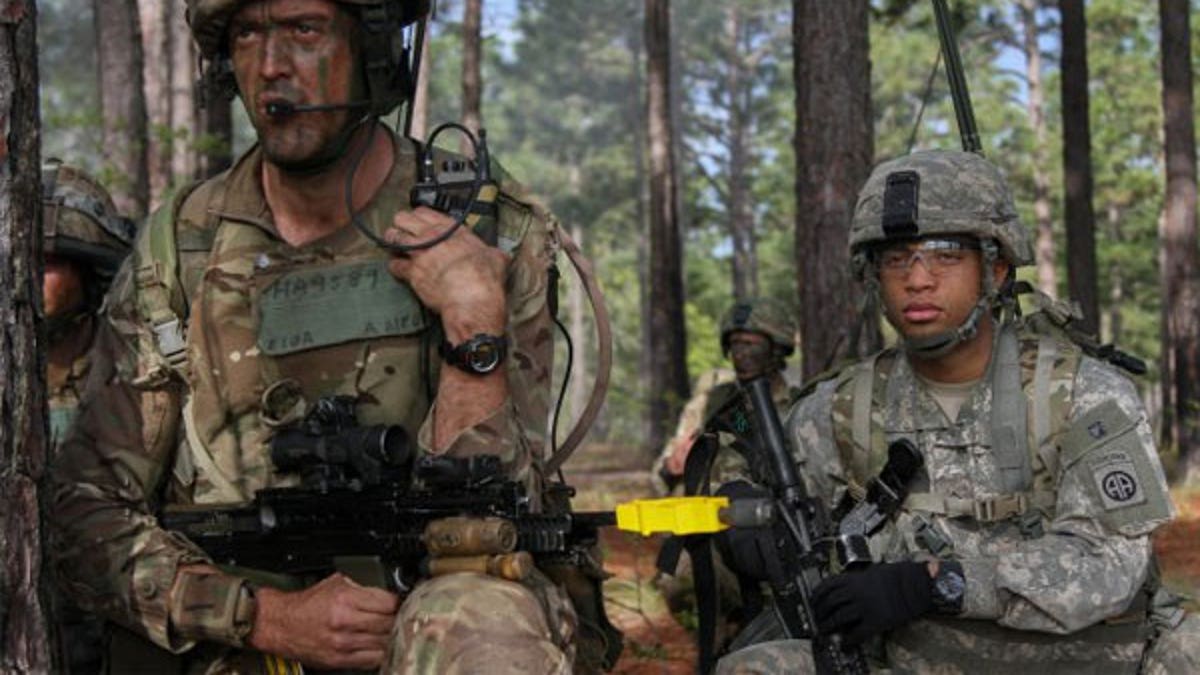
(Military.com)
The 82nd Airborne Division is now training more frequently with airborne units in the United Kingdom to expand the effectiveness of the U.S. Global Response Force.
Over the past couple of years, the 82nd -- which provides the conventional Army's forced entry capability to the Global Response Force strategy -- has been working to develop relationships with allied airborne units to become more efficient on the joint battlefield.
The U.S. and U.K. militaries agreed to increase their level of cooperation as Russia continues to mass forces on Ukraine's border execute fly overs near NATO exercises.
British paratroopers from the 3rd Battalion, Parachute Regiment, 16th Air Assault Brigade -- also known as 3 Para -- came to Fort Bragg, N.C., in April to train with 82nd Airborne's 2nd Brigade Combat.
"They are 100 percent all in on this," Col. Joseph Ryan told reporters at a June 10 Pentagon round table.
"I give them great credit they have been leaning forward and making sure this was a success and a testament of our shared vision of the world. … We have been extremely proud and satisfied of their level of commitment and level of will to engage in this relationship … earlier than the crisis, so now we are very confident that on a distant battlefield, we can be more effective earlier."
The 2nd BCT has been servicing as the rapid-deployment element of the U.S. GRF since October 2014 and will continue the rotation until it's replaced by the 1st BCT in December.
The GRF brigade is responsible for launching an airborne battalion on a global mission within 18 hours. The rest of the brigade deploys within 96 hours.
The GRF also consists of a Stryker and mechanized combat units as well as aviation assets to meet the Army requirement for a number of missions ranging from direct action to humanitarian assistance.
In late August, 1st BCT from the 82nd will participate in Exercise Quick Response alongside military units from 10 nations at a training center at Hohenfels, Germany and possibly in Romania and Bulgaria as well, Ryan said.
"It's an opportunity to look at how we can join up in stride and then build the team from there," Ryan said, expressing his hope that the 82nd will forge similar relationships to the one it enjoys with the elements of 16th Air Assault Brigade.
"There will be some challenges similar to the ones already worked out with the 16th, but that's OK. You've got to exercise; if you don't exercise, we will never figure it out."
75th Ranger Regiment
In addition to relationships with foreign units, the 82nd continues to coordinate with special operations units such as the 75th Ranger Regiment, a force that has been tapped in the past to conduct initial, forced-entry mission such as a parachute assault.
"I have been on that 'hey, you've got to go now' and I have been on that 'hey you've got to wait while the other guys go' side of that throughout my 24 year career," said Ryan, who served 10 years in the 75th.
"What I tell my brigade is … it's not my decision on who goes, where we go, why we go -- let's just be ready to go. That's our job, and we take that pretty seriously."
The 75th Ranger Regiment is a special operations unit that performs airfield seizures like the 82nd.
"But there are differences to what we can provide versus what they can provide, on both the positive and the negative," Ryan said.
"They are a specialized raid force. … They are lighter and less sustainable and I think that is where the greatest capacity of the 82nd comes in is in our mass, our concentration of combat power and in our ability to reinforce internally and provide a viable follow-on operating force to perform other missions much as any infantry brigade combat team."
Elements of the 82nd have trained with the 75th several times recently to prepare for an upcoming exercise in early August at the National Training Center at Fort Irwin, Calif., that will involve other special-operations units as well, Ryan said.
"I have many personal and professional friends in that organization and we maintain a very strong dialogue," Ryan said. "The ties between the units are very strong."
One of the challenges with working with foreign allies is achieving interoperability with communications equipment and mission-command software.
"We have work-arounds for every friction point that we have encountered, yet some of the work-arounds are more cumbersome than others," Ryan said.
One of these involved the creation of the Expeditionary Digital Support Liaison Team.
"Think of that as a group of individuals with U.S.-based Army battle command systems that simply embeds with a partner unit and provides them our services and interprets it for them and uses it with them, so that they can have a common operating picture with us, and they can add to the common operating picture from their perspective," Ryan said.
One plan is to have these support teams ready and provide UK and other units with Army Battle Command systems, so they can become comfortable working with them, Ryan said.
"And there is a cost to them to do that," he said. "They have to come to the table wanting that, knowing that they have to do that and spending the money to get that done."
The 16th AA Brigade in the UK has signed up to do just that, "but essentially that is what it is going to take with some of our other partners to make it work effectively, so this is a two-way street," Ryan added.
--Matthew Cox can be reached at matthew.cox@military.com.

